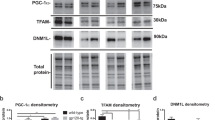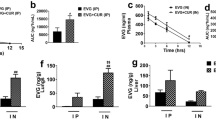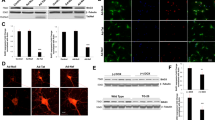Abstract
Human immunodeficiency virus-1 (HIV-1) is the most frequent cause of dementia in adults under 40. We sought to use gene delivery to protect from HIV-1-related neuron loss. Because HIV-1 envelope (Env) gp120 elicits oxidant stress and apoptosis in cultured neurons, we established reproducible parameters of Env-mediated neurotoxicity in vivo, then tested neuroprotection using gene delivery of antioxidant enzymes. We injected 100–500 ng μl−1gp120 stereotaxically into rat caudate–putamens (CP) and assayed brains for apoptosis by terminal deoxynucleotidyl transferase-mediated biotinylated UTP nick end labeling (TUNEL) 6-h to 14-day post-injection. Peak apoptosis occurred 1 day after injection of 250 and 500 ng μl−1gp120. TUNEL-positive cells mostly expressed neuronal markers (NeuroTrace), although some expressed CD68 and so were most likely microglial cells. Finally, we compared neuroprotection from gp120-induced apoptosis provided by localized and generalized intra-central nervous system (CNS) gene delivery. Recombinant SV40 vectors carrying Cu/Zn superoxide dismutase (SOD1) or glutathione peroxidase (GPx1) were injected into the CP, where gp120 was administered 4–24 weeks later. Alternatively, we inoculated the vector into the lateral ventricle (LV), with or without prior intraperitoneal (i.p.) administration of mannitol. Intracerebral injection of SV(SOD1) or SV(GPx1) significantly protected neurons from gp120-induced apoptosis throughout the 24-week study. Intraventricular vector administration protected from gp120 neurotoxicity comparably, particularly if preceded by mannitol i.p. Thus, HIV-1 gp120 is neurotoxic in vivo, and intracerebral or intra-ventricular administration of rSV40 vectors carrying antioxidant enzymes is neuroprotective. These findings suggest the potential utility of both localized and widespread gene delivery in treating neuroAIDS and other CNS diseases characterized by excessive oxidative stress.
This is a preview of subscription content, access via your institution
Access options
Subscribe to this journal
Receive 12 print issues and online access
$259.00 per year
only $21.58 per issue
Buy this article
- Purchase on Springer Link
- Instant access to full article PDF
Prices may be subject to local taxes which are calculated during checkout






Similar content being viewed by others
References
Mattson MP, Haughey NJ, Nath A . Cell death in HIV dementia. Cell Death Diff 2005; 12: 893–904.
Major EO, Rausch D, Marra C, Clifford D . HIV-associated dementia. Science 2000; 288: 440–442.
McArthur JC, Hoover DR, Bacellar H, Miller EN, Cohen BA, Becker JT et al. Dementia in AIDS patients: incidence and risk factors. Multicenter AIDS Cohort Study. Neurology 1993; 43: 2245–2252.
Koutsilieri E, Sopper S, Scheller C, ter Meulen V, Riederer P . Parkinsonism in HIV dementia. J Neural Transm 2002; 109: 767–775.
Ellis RJ, Deutsch R, Heaton RK, Marcotte TD, McCutchan JA, Nelson JA et al. Cognitive impairment is an independent risk factor for death in HIV infection. San Diego HIV Neurobehavioral Research Center Group. Arch Neurol 1997; 54: 416–424.
Ances BM, Ellis RJ . Dementia and neurocognitive disorders due to HIV-1 infection. Semin Neurol 2007; 27: 86–92.
Nath A, Sacktor N . Influence of highly active antiretroviral therapy on persistence of HIV in the central nervous system. Curr Opin Neurol 2006; 19: 358–361.
Ranki A, Nyberg M, Ovod V, Haltia M, Elovaara I, Raininko R et al. Abundant expression of HIV Nef and Rev proteins in brain astrocytes in vivo is associated with dementia. AIDS 1995; 9: 1001–1008.
van de Bovenkamp M, Nottet HS, Pereira CF . Interactions of human immunodeficiency virus-1 proteins with neurons: possible role in the development of human immunodeficiency virus-1 associated dementia. Eur J Clin Invest 2002; 32: 619–627.
Cicala C, Arthos J, Rubbert A, Selig S, Wildt K, Cohen OJ et al. HIV-1 envelope induces activation of caspase-3 and cleavage of focal adhesion kinase in primary human CD4(+) T cells. Proc Natl Acad Sci USA 2000; 97: 1178–1183.
Twu C, Liu NQ, Popik W, Bukrinsky M, Sayre J, Roberts J et al. Cardiomyocytes undergo apoptosis in human immunodeficiency virus cardiomyopathy through mitochondrion- and death receptor-controlled pathways. Proc Natl Acad Sci USA 2002; 99: 14386–14391.
Garden GA, Guo W, Jayadev S, Tun C, Balcaitis S, Choi J et al. HIV associated neurodegeneration requires p53 in neurons and microglia. FASEB J 2004; 18: 1141–1143.
Xu Y, Kulkosky J, Acheampong E, Nunnari G, Sullivan J, Pomerantz RJ . HIV-1-mediated apoptosis of neuronal cells: proximal molecular mechanisms of HIV-1-induced encephalopathy. Proc Natl Acad Sci USA 2004; 101: 7070–7075.
Meucci O, Fatatis A, Simen AA, Bushell TJ, Gray PW, Miller RJ . Chemokines regulate hippocampal neuronal signaling and gp120 neurotoxicity. Proc Natl Acad Sci USA 1998; 95: 14500–14505.
Regulier EG, Reiss K, Khalili K, Amini S, Zagury JF, Katsikis PD et al. T-cell and neuronal apoptosis in HIV infection: implications for therapeutic intervention. Int Rev Immunol 2004; 23: 25–59.
Kruman I, Nath A, Mattson MP . HIV-1 protein Tat induces apoptosis of hippocampal neurons by a mechanism involving caspase activation, calcium overload, and oxidative stress. Exp Neurol 1998; 154: 276–288.
Kaul M, Lipton SA . Chemokines and activated macrophages in HIV gp120-induced neuronal apoptosis. Proc Natl Acad Sci USA 1999; 96: 8212–8216.
Lipton SA, Choi YB, Pan ZH, Lei SZ, Chen HS, Sucher NJ et al. A redox-based mechanism for the neuroprotective and neurodestructive effects of nitric oxide and related nitroso-compounds. Nature 1993; 364: 626–632.
Dreyer EB, Kaiser PK, Offermann JT, Lipton SA . HIV-1 coat protein neurotoxicity prevented by calcium channel antagonists. Science 1990; 248: 364–367.
Lipton SA, Sucher NJ, Kaiser PK, Dreyer EB . Synergistic effects of HIV coat protein and NMDA receptor-mediated neurotoxicity. Neuron 1991; 7: 111–118.
Agrawal L, Louboutin JP, Reyes BAS, van Bockstaele EJ, Strayer DS . Antioxidant enzyme gene delivery to protect from HIV-1 gp120-induced neuronal apoptosis. Gene Therapy 2006; 13: 1645–1656.
Dexter DT, Carter CJ, Wells FR, Javoy-Agid F, Agid Y, Lees A et al. Basal lipid perxidation in substantia nigra is increased in Parkinson's disease. J Neurochem 1987; 52: 381–389.
Rosen DR, Siddique T, Patterson D, Figlewicz DA, Sapp P, Hentati A et al. Mutations in Cu/Zn superoxide dismutase are associated with familial amyotrophic lateral sclerosis. Nature 1993; 362: 59–62.
Beal MF . Aging, energy, and oxidative stress in neurodegenerative diseases. Ann Neurol 1995; 38: 357–366.
Smith MA, Perry G . Free radical damage, iron, and Alzheimer's disease. J Neurol Sci 1995; 134: 92–94.
Smith MA, Sayre LM, Monnier VM, Perry G . Radical ageing in Alzheimer's disease. Trends Neurosci 1995; 18: 172–176.
Cao W, Carney JM, Duchon A, Floyd RA, Chevion M . Oxygen free radicals involvement in ischemia and reperfusion of the brain injury to brain. Neurosci Lett 1998; 88: 233–238.
Montoliu C, Valles S, Renau-Piqueras J, Guerri C . Ethanol-induced oxygen radical formation and lipid peroxidation in rat brain: effect of chronic alcohol consumption. J Neurochem 1994; 63: 1855–1862.
Smith CD, Carney JM, Starke-Reed PE, Oliver CN, Stadtman ER, Floyd RA et al. Excess brain protein oxidation and enzyme dysfunction in normal aging and in Alzheimer's disease. Proc Natl Acad Sci USA 1991; 88: 10540–10543.
Mollace V, Nottet HS, Clayette P, Turco MC, Muscoli C, Salvemini D et al. Oxidative stress and neuroAIDS: triggers, modulators and novel antioxidants. Trends Neurosci 2001; 24: 411–416.
Turchan J, Pocernich CB, Gairola C, Chauhan A, Schifitto G, Butterfield DA et al. Oxidative stress in HIV demented patients and protection ex vivo with novel antioxidants. Neurology 2003; 60: 307–314.
Agrawal L, Louboutin JP, Strayer DS . Preventing HIV-1 Tat-induced apoptosis using antioxidant enzymes: mechanistic and therapeutic implications. Virology 2007; 363: 462–472.
Cutler RG, Haughey NJ, Tammara A, McArthur JC, Nath A, Reid R et al. Dysregulation of sphingolipids and sterol metabolism by ApoE4 in HIV dementia. Neurology 2004; 63: 626–630.
Kruman I, Bruce-Keller AJ, Bredesen D, Waeg G, Mattson MP . Evidence that 4-hydroxynonenal mediates oxidative stress-induced neuronal apoptosis. J Neurosci 1997; 17: 5089–5100.
Bruce-Keller AJ, Li YJ, Lovell MA, Kraemer PJ, Gary DS, Brown RR et al. 4-Hydroxynonenal, a product of lipid peroxidation, damages cholinergic neurons and impairs visuospatial memory in rats. J Neuropathol Exp Neurol 1998; 57: 257–267.
Ridet JL, Bensadoun JC, Deglon N, Aebischer P, Zurn AD . Lentivirus-mediated expression of glutathione peroxidase: neuroprotection in murine models of Parkinson's disease. Neurobiol Dis 2006; 21: 29–34.
Hoehn B, Yenari MA, Sapolsky RM, Steinberg GK . Glutathione peroxidase overexpression inhibits cytochrome c release and proapoptotic mediators to protect neurons from experimental stroke. Stroke 2003; 34: 2489–2494.
Watanabe Y, Chu Y, Andresen JJ, Nakane H, Faraci FM, Heistad DD . Gene transfer of extracellular superoxide dismutase reduces cerebral vasospasm after subarachnoid hemorrhage. Stroke 2003; 34: 434–440.
Betz AL, Shakui P, Davidson BL . Gene transfer to rodent brain with recombinant adenoviral vectors: effects of infusion parameters, infectious titer, and virus concentration on transduction volume. Exp Neurol 1998; 150: 136–142.
Cao H, Koehler DR, Hu J . Adenoviral vectors for gene replacement therapy. Viral Immunol 2004; 17: 327–333.
Kaplitt MG, Leone P, Samulski RJ, Xiao X, Pfaff DW, O'Malley KL et al. Long-term gene expression and phenotypic correction using adeno-associated virus vectors in the mammalian brain. Nat Genet 1994; 8: 148–154.
Davidson BL, Stein CS, Heth JA, Martins I, Kotin RM, Derksen TA et al. Recombinant adeno-associated virus type 2, 4, and 5 vectors: transduction of variant cell types and regions in the mammalian central nervous system. Proc Natl Acad Sci USA 2000; 97: 3428–3432.
Fu H, Muenzer J, Samulski RJ, Breese G, Sifford J, Zeng X et al. Self-complementary adeno-associated virus serotype 2 vector: global distribution and broad dispersion of AAV-mediated transgene expression in mouse brain. Mol Ther 2003; 6: 911–917.
Burger C, Gorbatyuk OS, Velardo MJ, Peden CS, Williams P, Zolotukhin S et al. Recombinant AAV viral vectors pesudotyped with viral capsids from serotypes 1, 2, and 5 display differential efficiency and cell tropism after delivery to different regions of the central nervous system. Mol Ther 2004; 10: 302–317.
Naldini L, Blomer U, Gage FH, Trono D, Verma IM . Efficient transfer, integration, and sustained long-term expression of the transgene in adult rat brains injected with a lentiviral vector. Proc Natl Acad Sci USA 1996; 93: 11382–11388.
Blomer U, Naldini L, Kafri T, Trono D, Verma IM, Gage FH . Highly efficient and sustained gene transfer in adult neurons with a lentivirus vector. J Virol 1997; 71: 6641–6649.
Strayer DS, Milano J . SV40 mediates stable gene transfer in vivo. Gene Therapy 1996; 3: 581–587.
Sauter BV, Parashar B, Chowdhury NR, Kadakol A, Ilan Y, Singh H et al. A replication-deficient rSV40 mediates liver-directed gene transfer and a long-term amelioration of jaundice in gunn rats. Gastroenterology 2000; 119: 1348–1357.
Duan YY, Wu J, Zhu JL, Liu SL, Ozaki I, Strayer DS et al. Gene therapy for human alpha1-antitrypsin deficiency in an animal model using SV40-derived vectors. Gastroenterology 2004; 127: 1222–1232.
Mandel RJ, Rendahl KG, Spratt SK, Snyder RO, Cohen LK, Leff SE . Characterization of intrastriatal recombinant adeno-associated virus-mediated gene transfer of human tyrosine hydroxylase and human GTP-cyclohydrolase I in a rat model of Parkinson's disease. J Neurosci 1998; 18: 4271–4284.
Louboutin JP, Reyes BAS, Agrawal L, van Bockstaele EJ, Strayer DS . Strategies for CNS-directed gene delivery: in vivo gene transfer to the brain using SV40-derived vectors. Gene Therapy 2007; 14: 939–949.
Cordelier P, Van Bockstaele E, Calarota SA, Strayer DS . Inhibiting AIDS in the central nervous system: gene delivery to protect neurons from HIV. Mol Ther 2003; 7: 801–810.
Cordelier P, Morse B, Strayer DS . Targeting CCR5 with siRNAs: using recombinant SV40-derived vectors to protect macrophages and microglia from R5-tropic HIV. Oligonucleotides 2003; 13: 281–294.
Anderson DW, Cordelier P, Strayer DS, Schneider JS . Viral gene delivery of GAD antisense genes to basal ganglia output neurons promoters behavioral recovery in a rat Parkinson model. Movement Dis 2002; 17: S58.
Ghodsi A, Stein C, Derksen T, Martins I, Anderson RD, Davidson BL . Systemic hyperosmolarity improves beta-glucuronidase distribution and pathology in murine MPS VII brain following intraventricular gene transfer. Exp Neurol 1999; 160: 109–116.
Mastakov MY, Baer K, Xu R, Fitzsimons H, During MJ . Combined injection of rAAV with mannitol enhances gene expression in the rat brain. Mol Ther 2001; 3: 225–232.
Bourgoin C, Emiliani C, Kremer EJ, Gelot A, Tancini B, Gravel RA et al. Widespread distribution of beta-hexosaminidase activity in the brain of a Sandhoff mouse model after coinjection of adenoviral vector and mannitol. Gene Therapy 2003; 10: 1841–1849.
Burger C, Nguyen FN, Deng J, Mandel RJ . Systemic mannitol-induced hyperosmolarity amplifies rAAV2-mediated striatal transduction to a greater extent than local co-infusion. Mol Ther 2005; 11: 327–331.
Doran SE, Ren XD, Betz AL, Pagel MA, Neuwelt EA, Roessler BJ et al. Gene expression from recombinant viral vectors in the central nervous system after blood–brain barrier disruption. Neurosurgery 1995; 36: 965–970.
McKee HJ, Strayer DS . Immune responses against SIV envelope glycoprotein, using recombinant SV40 as a vaccine delivery vector. Vaccine 2002; 20: 3613–3625.
Solbrig MV, Koob GF, Parsons LH, Kadota T, Horscroft N, Briese T et al. Neurotrophic factor expression after CNS viral injury produces enhanced sensitivity to psychostimulants: potential mechanisms for addiction vulnerability. J Neurosci 2000; 20: RC104 (1–6).
Strayer DS . Gene therapy using SV40-derived vectors: what does the future hold? J Cell Physiol 1999; 181: 375–384.
Strayer DS, Kondo R, Milano J, Duan LX . Use of SV40-based vectors to transduce foreign genes to normal human peripheral blood mononuclear cells. Gene Therapy 1997; 4: 219–225.
Strayer DS, Lamothe M, Wei D, Milano J, Kondo R . Generation of recombinant SV40 vectors for gene transfer. SV40 protocols. In: Raptis L (ed). Methods in Molecular Biology, vol. 165. Humana Press: Totowa, NJ, USA, 2001, pp 103–117.
Strayer DS, Mitchell C, Geverd D, Nichols CN . Papoviruses SV40. In: Friedmann T, Rossi JR (eds). DNA Delivery/Gene Transfer Manual. Cold Spring Harbor Press: New York, 2007, pp 273–287.
Paxinos G, Watson C . The Rat Brain in Stereotaxic Coordinates, 2nd edn. Academic Press: New York, 1986.
Rouger K, Louboutin JP, Villanova M, Cherel Y, Fardeau M . X-linked vacuolated myopathy: TNF-alpha and IFN-gamma expression in muscle fibers with MHC class I on sarcolemma. Am J Pathol 2001; 158: 355–359.
Acknowledgements
We thank Mr David Knowlton for technical assistance. We are also grateful to Dr Pierre Cordelier for important scientific discussions, suggestions and advice. This work was supported by NIH Grants MH69122, MH70287 and AI48244.
Author information
Authors and Affiliations
Corresponding author
Rights and permissions
About this article
Cite this article
Louboutin, JP., Agrawal, L., Reyes, B. et al. Protecting neurons from HIV-1 gp120-induced oxidant stress using both localized intracerebral and generalized intraventricular administration of antioxidant enzymes delivered by SV40-derived vectors. Gene Ther 14, 1650–1661 (2007). https://doi.org/10.1038/sj.gt.3303030
Received:
Revised:
Accepted:
Published:
Issue Date:
DOI: https://doi.org/10.1038/sj.gt.3303030
Keywords
This article is cited by
-
Endolysosome iron restricts Tat-mediated HIV-1 LTR transactivation by increasing HIV-1 Tat oligomerization and β-catenin expression
Journal of NeuroVirology (2021)
-
Intracisternal rSV40 administration provides effective pan-CNS transgene expression
Gene Therapy (2012)
-
Gene transfer to the rhesus monkey brain using SV40-derived vectors is durable and safe
Gene Therapy (2011)
-
Efficient CNS gene delivery by intravenous injection
Nature Methods (2010)
-
Efficient gene transfer using the human JC virus-like particle that inhibits human colon adenocarcinoma growth in a nude mouse model
Gene Therapy (2010)



